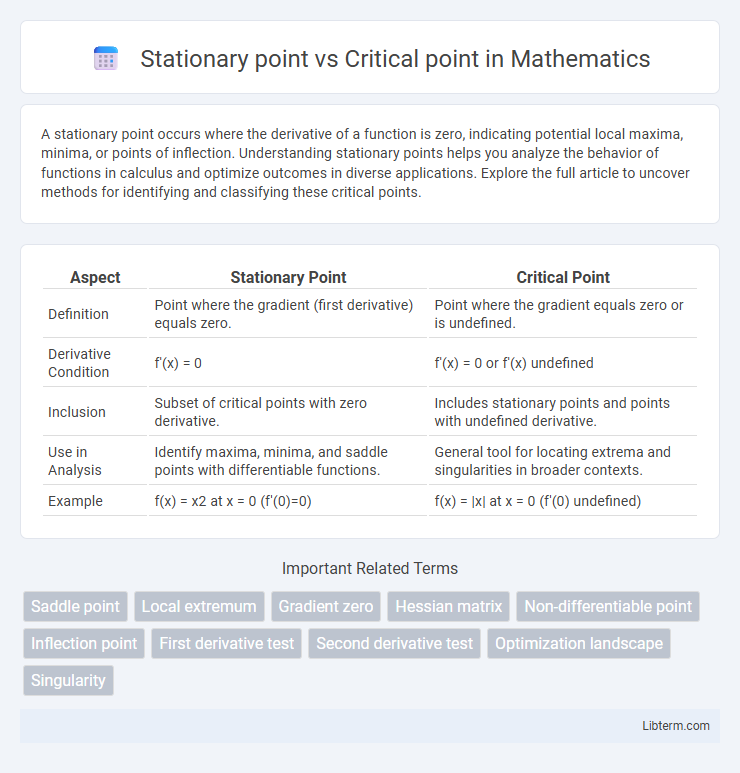A stationary point occurs where the derivative of a function is zero, indicating potential local maxima, minima, or points of inflection. Understanding stationary points helps you analyze the behavior of functions in calculus and optimize outcomes in diverse applications. Explore the full article to uncover methods for identifying and classifying these critical points.
Table of Comparison
| Aspect | Stationary Point | Critical Point |
|---|---|---|
| Definition | Point where the gradient (first derivative) equals zero. | Point where the gradient equals zero or is undefined. |
| Derivative Condition | f'(x) = 0 | f'(x) = 0 or f'(x) undefined |
| Inclusion | Subset of critical points with zero derivative. | Includes stationary points and points with undefined derivative. |
| Use in Analysis | Identify maxima, minima, and saddle points with differentiable functions. | General tool for locating extrema and singularities in broader contexts. |
| Example | f(x) = x2 at x = 0 (f'(0)=0) | f(x) = |x| at x = 0 (f'(0) undefined) |
Introduction to Stationary Points and Critical Points
Stationary points occur where the first derivative of a function is zero, indicating potential local maxima, minima, or saddle points. Critical points include stationary points as well as points where the derivative is undefined, expanding the analysis of function behavior. Understanding the distinction between stationary and critical points is essential for accurately identifying and classifying key features in calculus and optimization problems.
Definitions: What is a Stationary Point?
A stationary point is a point on a differentiable function's graph where the first derivative equals zero, indicating no instantaneous rate of change or slope. It signifies potential local maxima, minima, or saddle points in the function's behavior. This contrasts with critical points, which include points where the derivative is zero or undefined.
Definitions: What is a Critical Point?
A critical point of a function occurs where its derivative is zero or undefined, indicating potential locations for local maxima, minima, or saddle points. A stationary point is a specific type of critical point where the derivative is exactly zero, signifying flat tangents on the graph. Understanding critical points involves analyzing points where the function's slope changes behavior, crucial for optimization and curve sketching in calculus.
Mathematical Criteria for Stationary Points
A stationary point occurs where the first derivative of a function equals zero, indicating a potential maximum, minimum, or saddle point. Critical points include stationary points and points where the derivative does not exist, expanding the scope beyond just zeros of the derivative. The classification of stationary points relies on the second derivative test, where a positive second derivative indicates a local minimum, a negative second derivative indicates a local maximum, and a zero value requires higher-order derivative analysis.
Mathematical Criteria for Critical Points
A critical point of a function occurs where its first derivative is zero or undefined, defining potential locations for local maxima, minima, or saddle points. Stationary points are a subset of critical points specifically where the first derivative equals zero, indicating horizontal tangent lines on the function's graph. The mathematical criteria for critical points require evaluating f'(x) = 0 or f'(x) does not exist, while stationary points strictly satisfy f'(x) = 0.
Key Differences Between Stationary and Critical Points
Stationary points occur where the first derivative of a function equals zero, indicating potential local maxima, minima, or saddle points, while critical points include both stationary points and points where the derivative does not exist. Critical points encompass a broader set, capturing singularities and discontinuities that stationary points exclude. Understanding these distinctions is essential in calculus for accurately analyzing function behavior and optimization problems.
Examples Demonstrating Stationary Points
Stationary points occur where the derivative of a function is zero, such as f(x) = x^3 - 3x^2 + 4 having a stationary point at x = 0, where f'(0) = 0. Critical points include stationary points and points where the derivative does not exist, for example, f(x) = |x| has a critical point at x = 0 despite the derivative being undefined there. An example demonstrating stationary points is f(x) = x^2, which has a stationary point at x = 0 because f'(0) = 0 and the function attains a local minimum at this point.
Examples Demonstrating Critical Points
Critical points occur where the derivative of a function equals zero or is undefined, such as at x = 0 for f(x) = x3, which has a flattening slope but no local max or min. Stationary points are a subset of critical points where the derivative is exactly zero, like at x = 1 for f(x) = (x-1)2, showing a local minimum. Examples like f(x) = |x| demonstrate critical points without stationary points because the derivative is undefined at x = 0.
Applications in Calculus and Optimization
Stationary points and critical points are essential in calculus and optimization for identifying local maxima, minima, and saddle points. A stationary point occurs where the first derivative of a function is zero, indicating potential extrema, while critical points include stationary points and points where the derivative is undefined. These concepts facilitate solving optimization problems in engineering, economics, and machine learning by enabling precise determination of optimal values and behavior of functions.
Summary: Choosing the Right Concept for Problem Solving
Stationary points occur where the derivative of a function is zero, indicating potential local maxima, minima, or saddle points, while critical points include stationary points and points where the derivative does not exist. Selecting between stationary and critical points depends on the function's differentiability and the nature of the problem, with critical points providing a broader framework for handling non-differentiable cases. Understanding the distinctions ensures accurate identification of solution candidates in optimization and calculus applications.
Stationary point Infographic

 libterm.com
libterm.com